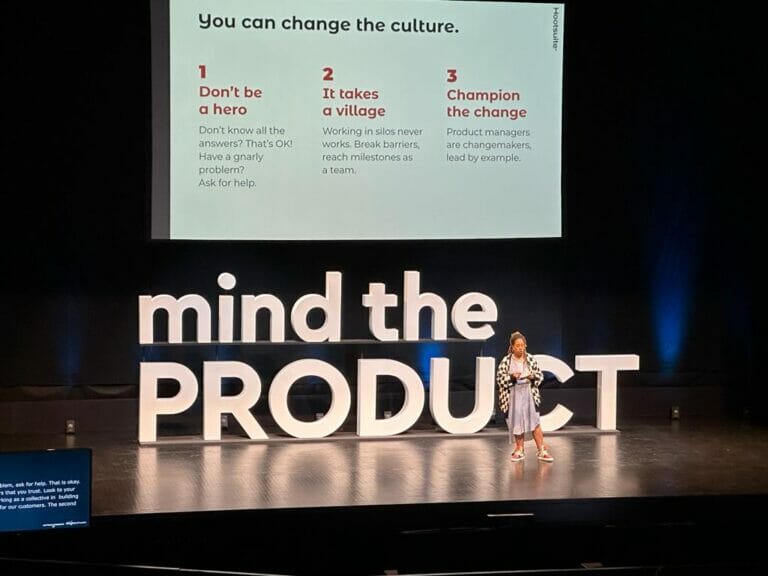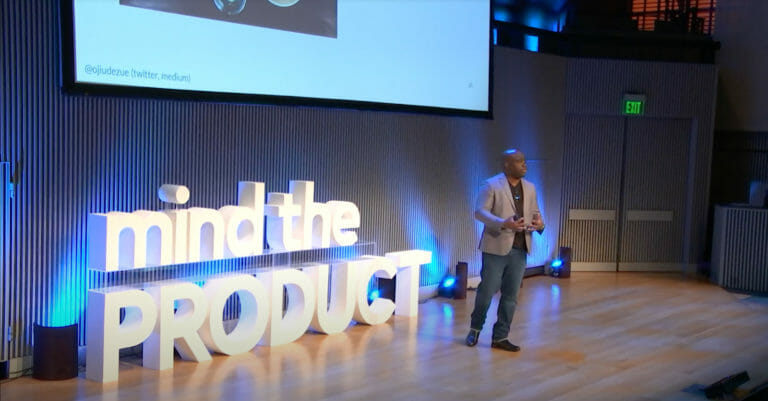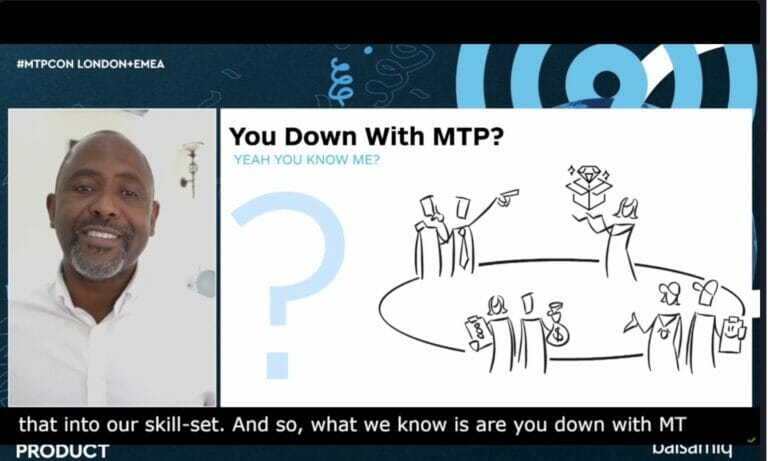The Keynote Kit
#mtpcon San Francisco 2023
On June 14 2023, eight esteemed product people took to the coveted #mtpcon keynote stage in San Francisco for a jam-packed day of inspiration and innovation. Our renowned speakers explored the world of product management, taught us new strategies, and inspired us to build better products.
New this year, our exciting Keynote Kit brings you all of the insights from our San Francisco keynote talks plus additional helpful discussion points and thought starters so you can easily translate the insights into actions – perfect for making effective improvements to your role, team, and product. Dive in below!
Published talks
- The magic of making great products with Christian Idiodi
- Measuring the user experience with Tomer Sharon
- The importance of psychological safety for remote teams with Diana Stepner
- Modern day leadership with Janice Fraser
- Going from 0 to 1 in product discovery with Merci Grace
- Mastering perspective – zoom in, zoom out as a product leader with Navya Rehani Gupta
- Creating courageous product teams with Yi-Wei Ang
- Lessons learned from leading products with Natalia Williams
The magic of making great products with Christian Idiodi
Innovation is a key aspect of building great products that customers love. In his #mtpcon San Francisco 2023 keynote session, Christian Idiodi, Partner at Silicon Valley Product Group, talked about how product managers can harness innovation and magic to make an impact on customers’ lives.
Turn the learnings into action
Are you struggling with making magical products? Ask these questions to yourself or your team after watching Christian’s keynote talk recording:
- Christian talks about taking risks in solving problems in product, through iteration, experimentation, prototyping, and testing. How often do you try to take risks when solving customers’ problems? Video time stamp: 14m50s to 15m35s (or jump to clip on Vimeo)
- Christian explains that our biggest flaw in business is not involving those who are closest to technology (engineers and developers) in the problem-solving process. How do you or your product leaders collaborate with teams when building your product? Could the process be improved? Video time stamp: 17m14s to 17m45s (or jump to clip on Vimeo)
- Christian says that most of our ideas fail. We must find ways to try new things quickly and inexpensively. What are the ways in which you can validate and test new ideas in your job? Video time stamp: 17m59s to 19m31s (or jump to clip on Vimeo)
- If you want to get better at product management, you have to practice your craft, Christian explains. What is the biggest aspect of product management that you would like to practice to better your craft? Video time stamp: 20m29s to 21m10s (or jump to clip on Vimeo)
By answering these questions, you can begin to build great products and master the arts of product magic.
Measuring the user experience with Tomer Sharon
In his #mtpcon San Francisco 2023 keynote talk, Tomer Sharon, Co-founder and CXO at workplace experience platform anywell, talks about measuring the user experience and the advantages of high-level metrics.
Turn the learnings into action
Do you need help with the user experience of your product? Ask these questions to yourself or your team after watching Tomer’s keynote talk recording:
- Tomer talks about how to measure the success of a rock concert – most people would think about ticket sales, but if you think about it, ticket sales happen before anyone has experienced anything. What high-level metrics can you track that measure the success of a rock concert? Video time stamp: 4m10s to 5m10s (or jump to clip on Vimeo)
- In user research, product teams’ biggest challenge is answering the question, ‘How are we doing as a product?’ He says that many teams focus on nit-picky-level metrics to tackle this question. What high-level metrics can you focus on, and what nitpicky team-level metrics can you deprioritise tracking? Video time stamp: 10m38s to 14m55s (or jump to clip on Vimeo)
- Tomer explains how important it is to focus on behaviour over opinions. Humans are biased and affected by things far beyond what we ask them. Consequently, their opinions can warp their impressions of products and services. What questions can you ask users to ensure that you focus on behaviour over opinions? Video time stamp: 15m30s to 19m55s (or jump to clip on Vimeo)
- When using OKRs, Tomer explains that it helps people work in the same direction. We can use high-level metrics to create effective OKRs. What metrics can you set to integrate into your OKR strategy? Video time stamp: 23m05s to 24m11s (or jump to clip on Vimeo)
By answering these questions, you can begin to have a better understanding of how well your product is performing for your users.
The importance of psychological safety for remote teams with Diana Stepner
In this #mtpcon San Francisco keynote, Diana Stepner, Head of Product, Education at Chan Zuckerberg Initiative, shared insights on the importance of psychological safety for remote teams.
Turn the learnings into action
How can you build psychological safe product teams during times of uncertainty? Diana Stepner had some key talking points to takeaway to embark on this journey. Try out the exercises below to ensure that you and your team feel safe and empowered.
- Diana explains that 82% of people have experienced some form of imposter syndrome. It’s something that we face in our daily lives and it’s something we can use to our advantage. How can you embrace your imposter syndrome in product management? Video time stamp: 4m20s to 6m38s (or jump to clip on Vimeo)
- Sharing mistakes in product has been proven to build psychologically safe and empowered teams, Diana says in her keynote. What mistakes could you share with your team today that will encourage empowerment and growth? Video time stamp: 15m54s to 17m15s (or jump to clip on Vimeo)
- Diana shares the Psychological Safety Quadrant to determine how safe and empowered your team feels. Try running this exercise with yourself or your team. Video time stamp: 19m14s to 20m30s (or jump to clip on Vimeo)
- To build psychologically safe teams, you can use retrospectives to reflect on things that you can be doing differently to enable teams to grow and shine. Take this activity that you’ve already used for sprints and features, and use them on yourself or your team. Video time stamp: 24m03s to 25m16s (or jump to clip on Vimeo)
Following these exercises, and embracing imposter syndrome can help you and your team to feel empowered and drive product success.
Modern day leadership with Janice Fraser
In this #mtpcon San Francisco keynote, Silicon Valley veteran and author Janice Fraser dives into the essentials of effective modern-day leadership and takes us through some of the findings in her book, co-authored with her husband, Farther, Faster and far less Drama.
Turn the learnings into action
What does the modern day mean for product leadership? In her keynote talk, Janice shares four key leadership motions you can apply to your daily practices as you embark on your leadership journey.
- Janice says we are taught many ways to set goals but not how to understand the current moment and where we need to go. Understand the situation, and ask what makes the situation complicated. You can then ask the right questions to find the answers. Try this technique to orient honestly and solve problems. Video time stamp: 17m54s to 21m15s (or jump to clip on Vimeo)
- Valuing outcomes are key in the product management process. Janice explains that when you value plans more than outcomes, it’s easy to mistake effort for achievement. Video time stamp: 21m37s to 23m07s (or jump to clip on Vimeo)
- Knowing who to collaborate with is imperative to effective leadership, says Janice. Focus on collaborating with the people with the information or expertise, those with the authority to say yes, and those who have to live with the outcome. Video time stamp: 24m42s to 25m54s (or jump to clip on Vimeo)
- Janice explains that we must change the standard by which we make decisions. Don’t take too long to decide; aim for the best and right call. Additionally, don’t make fast and chaotic decisions. Your decisions may be fast, but your productivity will be slow. Find a balance between speed and strength. Ask yourself these two questions to make durable decisions. “Can you live with it, and does it move us toward our desired outcome?” Video time stamp: 26m10s to 28m33s (or jump to clip on Vimeo)
Take these motions into your daily decision-making processes to reduce stress, become a great leader, and make great progress wherever you decide to lead.
Going from 0 to 1 in Product discovery with Merci Grace
In this #mtpcon San Francisco talk, Merci Grace, Angel investor, and former Head of Growth at Slack, offers an iterative framework to plan and execute the product discovery phase that provides value to your customer.
Turn the learnings into action
How can you go from 0 to 1 in building great products? The amazing Merci Grace, Angel investor and founder, led a keynote session on building a business model from scratch. Read on for her key actionable takeaways.
- Merci opens by speaking about generating ideas – the initial stage required to build products. She says she and her co-founder generated four ideas before honing in on an idea. When generating ideas, constrain your universe, choose your customer, deep dive into their problems, and describe possible outcomes. Video time stamp: 06m48s to 08m28s (or jump to clip on Vimeo)
- During the interview stage, Merci explains the importance of learning about customers’ lives and how they solve problems without your product. This will give you an understanding of their pain points. Video time stamp: 13m58s to 15m37s (or jump to clip on Vimeo)
- Merci says it is easy to assume that consumers may pay for something, but it’s important to use the Willingness-to-pay-interview framework to determine a price for your product. First, stack rank your consumers’ pain points, listen out for a potential business model, and then discover the price range of your product. Video time stamp: 17m10s to 22m47s (or jump to clip on Vimeo)
- The more bad ideas, the further ahead you will be, Merci says. It’s important to test assumptions to discover new things. Try and test new things more often to learn more about your customers and their problems. Video time stamp: 22m54s to 24m15s (or jump to clip on Vimeo)
Following these insights will aid you in validating a business model and building a product your customers truly need and love.
Mastering perspective – zoom in, zoom out as a product leader with Navya Rehani Gupta
In this #mtpcon San Francisco talk, Navya Rehani Gupta, Chief Product Officer at Peek shared insights on mastering perspectives as a product manager by learning how to zoom in and zoom out. Read on for Navya’s 4 actionable steps:
Turn the learnings into action
In her talk, Navya looks at the art of zooming in and zooming out and at finding the right focus for every perspective and every situation. Read on for Navya’s four actionable steps:
- Navya explains that to navigate through new perspectives in leadership. We must make room to zoom. No time is created equal, she explains. When encountering jobs-to-be-done, plan, execute, think ahead, and evaluate. Video time stamp: 10m14s to 12m16s (or jump to clip on Vimeo)
- Her second takeaway is to have conversations about conversations. Doing this helps you to come in with the right depth. Are you coming in as an expert? Are you coming in to make the final decisions? Asking these questions helps ensure you’re bringing your best self to a conversation. Additionally, use the framework P.O.P (purpose, outcome, and process) to align conversations. Video time stamp: 12m18s to 13m34s (or jump to clip on Vimeo)
- When you’re feeling stuck, step back and frame the situation more broadly. Navya says: “I often stop meetings and say ‘we can’t be the only ones trying to figure this out. Let’s see how others are’. Once you can take this step back and go back into the problem, you will be able to find details you were overlooking.” Video time stamp: 14m21s to 16m48s (or jump to clip on Vimeo)
- Finally, Navya says to aim towards getting better every day. Ask yourself these questions; How can I maximise my impact? What are the root causes of my lowlights? Which of my activities require an adjusted zoom setting? Video time stamp: 16m53s to 18m45s (or jump to clip on Vimeo)
By implementing these four steps, product managers can enhance their leadership abilities and drive success in product by zooming out and gaining new perspectives.
Creating courageous product teams with Yi-Wei Ang
In this #mtpcon San Francisco talk, Yi-Wei Ang, Chief Product Officer at Talabat, talks about why it’s important to develop a culture of courage in a product team and across a product organisation.
Turn the learnings into action
In his talk, Yi-Wei discussed how creating courageous teams can be the key to product innovation and exponential growth. Read on for his actionable steps!
- Yi-Wei explains that there is so much power in acknowledging that you don’t know all of the answers as a leader. When leading a team, try to be comfortable with being wrong and take a risk by placing bets when making decisions. Video time stamp: 07m13s to 10m03s (or jump to clip on Vimeo)
- To build a product organisation that makes courageous decisions, Yi-Wei explains that we must first build a culture that allows for vulnerability. Learning from your own mistakes is what will make teams successful. How many mistakes have you made recently that you can learn from and share with your team? Video time stamp: 10m41s to 12m25s (or jump to clip on Vimeo)
- To embark on this journey of vulnerability and courage, Yi-Wei says first to check your ego. It’s important to be the curious one and build a vulnerable muscle. In your next meeting, try to ask more questions and be open to learning more about the subject at hand. Video time stamp: 13m03s to 16m14s (or jump to clip on Vimeo)
- Yi-Wei says to build a level of vulnerability in product teams. Try these things with your team in your next meeting; model authentic vulnerability, learn, and grow together, lean into the difficult feelings in the room, and finally, never leave things unsaid. Video time stamp: 16m56s to 20m02s (or jump to clip on Vimeo)
Courage is contagious, Yi-Wei says. Build a culture that embraces vulnerability and encourages people to take risks. Doing this will guarantee powerful retention, talent acquisition, and business success.
Lessons learned from leading products with Natalia Williams
In this #mtpcon San Francisco talk, Natalia Williams, CPO of HootSuite, reflects on her journey as a product manager, the things she learned in her 20+ years of experience, and how you can leverage these lessons to evolve your company for the better.
Turn the learnings into action
In her talk, Natalia shared her key lessons from her various product leadership roles. Read on for some actionable questions to take into your regular practices.
- As product managers, we must understand that everything is about the customer. How can you change your thinking to focus on the customer at all times? Video time stamp: 05m35s to 07m51s (or jump to clip on Vimeo)
- Natalia says to be open to feedback as you may not always have the answers to your questions. Also, bring your team along on the journey. Think about how you can bring others into the conversation, reduce ‘busywork’, and increase collaboration to drive better outcomes. Video time stamp: 10m12s to 13m12s (or jump to clip on Vimeo)
- It takes a lot of resilience to embrace change; it’s a constant in our roles, Natalia says. As product managers, we must be open to change in product. When dealing with change, ask yourself, ‘Is this beneficial to the customer’? Answering this will ensure that you are comfortable in the discomfort of change. Video time stamp: 15m15s to 18m49s (or jump to clip on Vimeo)
- How can you start igniting change? First, consider high-cadence communication. There is no such thing as over-communication in product, Natalia says. Second, provide or ask for role clarity on product managers. Third, talk more and silo less—find ways to build bridges. Consider focusing on these three points to master change within product teams and the wider organisation. Video time stamp: 24m51s to 29m23s (or jump to clip on Vimeo)
Product management is full of many challenges and lots of turbulence. However, embracing change, being open to feedback, and always focusing on the customer can be key to building great products and leading teams effectively.


